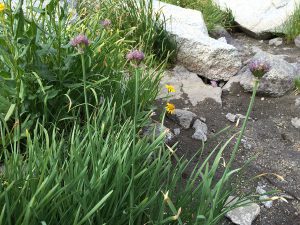How to Make Home-Cooked Meals for Trail and Camp
Tired of those freeze-dried back-packing meals from REI? It’s easy to have delicious and nutritious home-cooked stews and vegetables when you are in the woods. All it takes is some leftover stew, about 30 minutes of extra prep time and a dehydrator. Amazingly, the food loses none of it’s flavor and tastes just like it did at home.
Even if you aren’t a camper, it can be handy to keep some dehydrated meals on hand at home for other unplanned events, such as an emergency power outage or even an earthquake! While I have never stored them for more than a few weeks, I am told the dehydrated meats will last about six months stored in ziplock bags in a cool, dark place, or longer if stored in the freezer.
Here’s a classic beef stew recipe that works well for dehydrating. I’ve also used the same techniques successfully with leftover coq au vin (using boneless chicken), jalapeño pork stew and other favorite recipes. In the photo, we have added extra dehydrated carrots, dehydrated wild mushrooms and a few fresh, wild onion stalks which were growing near our campsite.
Trekker’s Beef Stew Recipe
3 pounds grass-fed beef stew meat, cut into 1-inch chunks
3-4 cups beef broth (preferably home made)
4 stalks celery, chopped
1 yellow onion, chopped
6-8 red potatoes, chopped
1 lb. carrots, chopped
6 cloves garlic
a few sprigs of fresh thyme, parsley and rosemary
salt and pepper to taste
3 tablespoons olive oil
In a cast iron dutch oven, heat the olive oil and brown the cubes of beef on all sides. Add in all the ingredients except the carrots and potatoes. Simmer for about an hour, add the carrots and potatoes, and simmer for another 1.5-2 hours. Alternatively, place the stew in the oven on 300 degrees and let it cook for several hours.
Dehydrating the Beef Stew
While it is possible to dehydrate foods in the oven, it is much more efficient to use a dehydrator. I highly recommend the Excalibur Nine-Tray dehydrator. You will also need plastic drying sheets to line the dehydrator trays. These are inexpensive and widely available on line.
- Take whatever amount of beef stew you wish to dehydrate and measure it by volume. After it is dehydrated, measure it again. This gives you a guideline for the amount of water needed to rehydrate the stew. (We usually don’t bother with this step, and just approximate the amount of water we need. If this is your first time using this technique, it can be a useful guide.)
- Separate the meat cubes from the vegetables and gravy.
- Tip: For faster dehydration and rehydration, shred the meat cubes.
- Place the meat cubes on dehydrator trays that are lined with plastic sheets.
- Place the vegetable cubes and gravy on dehydrator trays lined with plastic sheets, separate from the meat.
- Tip: cut the vegetable cubes into smaller pieces (.25 inches) for faster dehydration and rehydration time.
- Set the dehydrator on 155 degrees (the recommended setting for meat).
- Let it dehydrate over night, 8-12 hours. Check it in the morning. Add more time if needed. The meat and vegetables will dehydrate at different rates, depending on how they are cut.
- Meat pieces should feel completely dry and not pliable, if shredded.
- Vegetable pieces should feel dry completely through the middle.
- Gravy should be dried onto the plastic liner and should have a leathery texture.
- Place the dehydrated meat and the dehydrated vegetables with gravy in separate plastic ziplock bags, label, date and store until needed.
- If you measured the volume before dehydration, measure it again and note the volume of water needed to rehydrate.
Rehydrating the Beef Stew
Rehydration times vary depending on the size of the pieces, temperature of the water, and elevation. If you are camping above 5000 ft. elevation, rehydration will take a little longer. Hot water will reduce the rehydration time, but it is possible to rehydrate with cold water. The shredded meat will take about 20-30 minutes to rehydrate. If the meat is cubed, it could take several hours to rehydrate.
- Place the shredded beef in a pot with an appropriate volume of hot water. Wait 15 minutes.
- Check the beef, and add vegetables and gravy. Add more hot water, if the initial water has been soaked up. Wait another 15 minutes.
- Check the stew again. If the texture is soft, reheat the stew on the camp stove until it is hot enough to eat. If not, wait a little longer and recheck.
- Serve hot with fresh mountain air and a healthy appetite!





